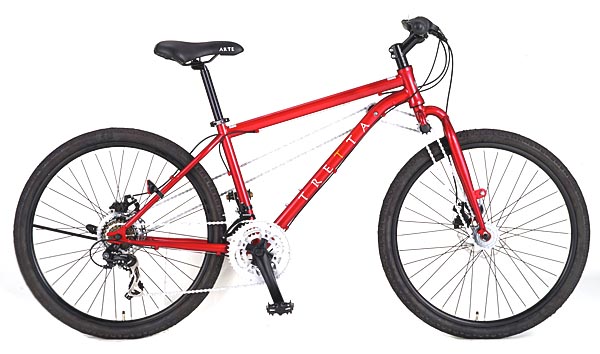
Bicycles perform excellently in the kind of conditions that have paralysed many roads this week. It’s easy to assume that a bicycle is the worst possible option in snow, but this is not the case. Although riding on ice can prove tricky, a light covering of snow should not present any difficulties for an experienced rider. Keep your weight towards the rear wheel, make most use of the rear brake (gently) and run a slightly lower tyre pressure. There are accessories available to adapt bikes for snowy conditions – from metal-studded tyres to full caterpillar track systems – but most are little more than gimmicks.
2-wheel drive
Japanese bicycle manufacturer Tretta has a range of 2 wheel drive bikes. The MTB uses an additional – and very long – that chain stretches from the rear hub to a set of small cogs near the top of the down tube. There are advantages in having both wheels driven, but this design adds weight and unnecessary complexity.
Caterpillar tracks
An even more complex answer to the question of how best to cycle in snow is the caterpillar track bike. Although it looks like it means business, when we tested one at the snow dome in Milton keynes, we found it didn’t perform any better than a conventional mountain bike.


Testing (and crashing) a snow bike at the Snow Dome
Ice tyre hack
Cyclists are a resourceful bunch, but this solution to the problem of icy roads is particularly ingenious. Imaginative cyclists are adapting their bikes for use on icy roads by fitting their bicycle tyres with cables ties. The cable ties take only a few minutes to fit and provide impressive traction on the most slippery of surfaces. The cable ties are inexpensive to buy, and can be fitted to bikes (with coaster or disc brakes) without tools in very little time.
Cable ties cost about 3 pence each and each tyre needs around 15 ties. Once the period of cold weather has passed they can be cut away and discarded. Alternatively, buy the reusable type or use the head of a small screw driver to release the cable and re-use. The technique is suitable only for bicycles fitted with disc or hub brakes, but it is possible to adapt any bicycle tyre for use on ice by adding pop rivets for less than £2.
Protection for you and your bike
A true test of a cycle insurance company is what happens when you make a claim – it’s why we don’t farm out the process to a third party like other providers. Your claim is dealt with by one of us here and you’re always welcome to call us directly. It’s also the reason we will never devalue your bicycle, no matter how old it is.
We don’t claim to be the cheapest cover on the market, but should you ever need to make a claim, you’ll understand why we consider ourselves to be the best. After all, we are judged by The Good Shopping Guide to be Britain’s most ethical provider.


0 Comments View now